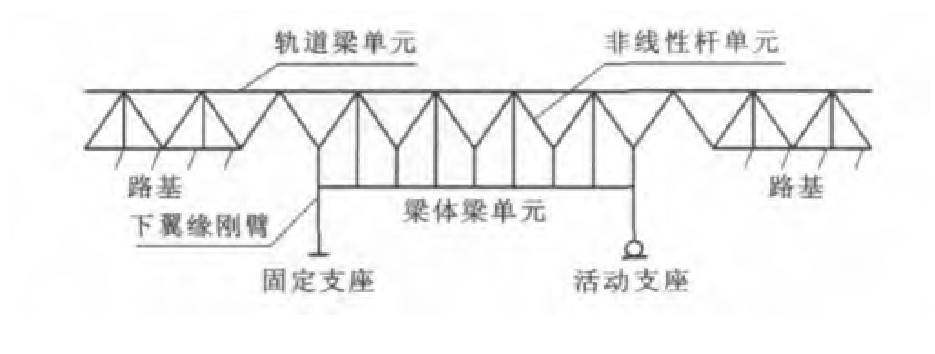Design parameters of track-bridge interaction on passenger dedicated line cable-stayed bridge
-
摘要: 采用非线性弹簧模拟桥梁和轨道的相互作用, 根据相关文献的试验结果对模拟方法进行验证。以沪昆客运专线上某槽型截面独塔斜拉桥为算例, 采用大型通用有限元软件ANSYS建立了塔-索-轨-梁-墩统一的空间有限元模型, 对斜拉桥钢轨纵向力的传递规律进行了分析, 研究了纵向阻力模型、斜拉桥结构体系、温度荷载与风荷载等设计参数对钢轨纵向力的影响。分析结果表明: 钢轨纵向阻力可按理想弹塑性模型进行简化; 与漂浮体系相比, 塔梁固结可减小约30%的钢轨纵向力; 在计算钢轨伸缩力时可按照梁体升温15℃和拉索升温40℃加载; 在风速较大的地区, 风力引起的斜拉桥上钢轨纵向力可超过60kN。Abstract: Track-bridge interaction was simulated by using nonlinear spring, and the simulation method was proved based on the experimental results of related documents.Taking a U-shape section and single-tower cable-stayed bridge on Shanghai-Kunming Passenger Dedicated Line as an example, the spatial finite element model of tower-cable-rail-beam-pier was established by using large general-purpose finite element software ANSYS.The transfer law of rail longitudinal force on cable-stayed bridge was analyzed, and the impacts of design parameters on rail longitudinal force were studied, the design parameters included longitudinal resistance model, cable-stayed bridge structure system, temperature load, wind load and so on.Analysis result shows that rail longitudinal resistance can be simplified in accordance with ideal elastic-plastic model.Compared with floating system, rail longitudinal force reduces by about 30% through tower and beam consolidation.When calculating rail expansion force, load can be applied according to beam increasing-temperature 15 ℃ and cable increasing-temperature 40 ℃.In windy areas, rail longitudinal force on cable-stayed bridge caused by wind can be larger than 60 kN.
-
图 1 文献[1]中所采用的有限元模型
Figure 1. Finite element model in reference 1
表 1 不同刚臂刚度下钢轨挠曲力
Table 1. Rail bending forces with different rigid arm stiffnesses

表 2 模型计算结果
Table 2. Model calculation results

表 3 频率与振型对比
Table 3. Comparison of frequencies and vibration modes

表 4 道床纵向阻力模型
Table 4. Longitudinal resistance models of track bed

表 5 斜拉桥纵向约束方式
Table 5. Longitudinal restraint plans of cable-stayed bridge

表 6 最大钢轨伸缩力
Table 6. Maximum rail expansion forces

-
[1] 卜一之. 高速铁路桥梁纵向力传递机理研究[D]. 成都: 西南交通大学, 1998.BU Yi-zhi. Research on the transmission mechanism of longitudinal force for high-speed railway bridges[D]. Chengdu: Southwest Jiaotong University, 1998. (in Chinese). [2] 徐庆元. 高速铁路桥上无缝线路纵向附加力三维有限元静力与动力分析研究[D]. 长沙: 中南大学, 2005.XU Qing-yuan. Static and dynamic 3Dfinite element analysis of additional longitudinal forces transmission between CWR and high-speed railway bridges[D]. Changsha: Central South University, 2005. (in Chinese). [3] 徐庆元, 陈秀方, 李树德. 高速铁路桥上无缝线路纵向附加力研究[J]. 中国铁道科学, 2006, 27(3): 8-12. https://www.cnki.com.cn/Article/CJFDTOTAL-ZGTK200603001.htmXU Qing-yuan, CHEN Xiu-fang, LI Shu-de. Study on the additional longitudinal forces transmission between continuously welded rails and high-speed railway bridges[J]. China Railway Science, 2006, 27(3): 8-12. (in Chinese). https://www.cnki.com.cn/Article/CJFDTOTAL-ZGTK200603001.htm [4] 张建. 刚构桥上无缝线路的ANSYS分析及二次开发[D]. 长沙: 中南大学, 2007.ZHANG Jian. ANSYS analysis and secondary exploitation of CWR on rigid frame bridge[D]. Changsha: Central South University, 2007. (in Chinese). [5] SONG M K, NOH H C, CHOI C K. A new three-dimensional finite element analysis model of high-speed train-bridge interactions[J]. Engineering Structures, 2003, 25(13): 1611-1626. doi: 10.1016/S0141-0296(03)00133-0 [6] RUGE P, WIDARDA D R, SCHMALZLIN G, et al. Longi-tudinal track-bridge interaction due to sudden change of coup-ling interface[J]. Computers and Structures, 2009, 87(1/2): 47-58. [7] BATTINI J M, MAHIR U K. A simple finite element to consider the non-linear influence of the ballast on vibrations of railway bridges[J]. Engineering Structures, 2011, 33(9): 2597-2602. doi: 10.1016/j.engstruct.2011.05.005 [8] 阴存欣. 铁路桥梁纵向附加力的静动力非线性分析与仿真研究[D]. 北京: 中国铁道科学研究院, 2000.YIN Cun-xin. Study on nonlinear static and dynamic analysis and emulation of additional longitudinal forces in railway bridges[D]. Beijing: China Academy of Railway Sciences, 2000. (in Chinese). [9] FREIRE A M S, NEGRAO J H O, LOPES A V. Geomet-rical nonlinearities on the static analysis of highly flexible steel cable-stayed bridges[J]. Computers and Structures, 2006, 84(31/32): 2128-2140. [10] DANIELL W E, MACDONALD J H G. Improved finite ele-ment modelling of a cable-stayed bridge through systematic manual tuning[J]. Engineering Structures, 2007, 29(3): 358-371. doi: 10.1016/j.engstruct.2006.05.003 [11] Germany DS899/59, special procedures on railway Shinkansen bridge[S]. [12] LIM N H, PARK N H, KANG Y J. Stability of continuous welded rail track[J]. Computers and Structures, 2003, 81(22/23): 2219-2236. [13] 闫斌, 戴公连. 高速铁路斜拉桥梁轨相互作用[R]. 长沙: 中南大学, 2011.YAN Bin, DAI Gong-lian. Beam-track interaction on high-speed railway cable-stayed bridge[R]. Changsha: Central South University, 2011. (in Chinese). [14] RUGE P, BIRK C. Longitudinal forces in continuously welded rails on bridgedecks due to nonlinear track-bridge interaction[J]. Computers and Structures, 2007, 85(7/8): 458-475. [15] TB10002.1—2005, 铁路桥涵设计基本规范[S].TB10002.1—2005, fundamental code for design on railway bridge and culvert[S]. -





 下载:
下载:








